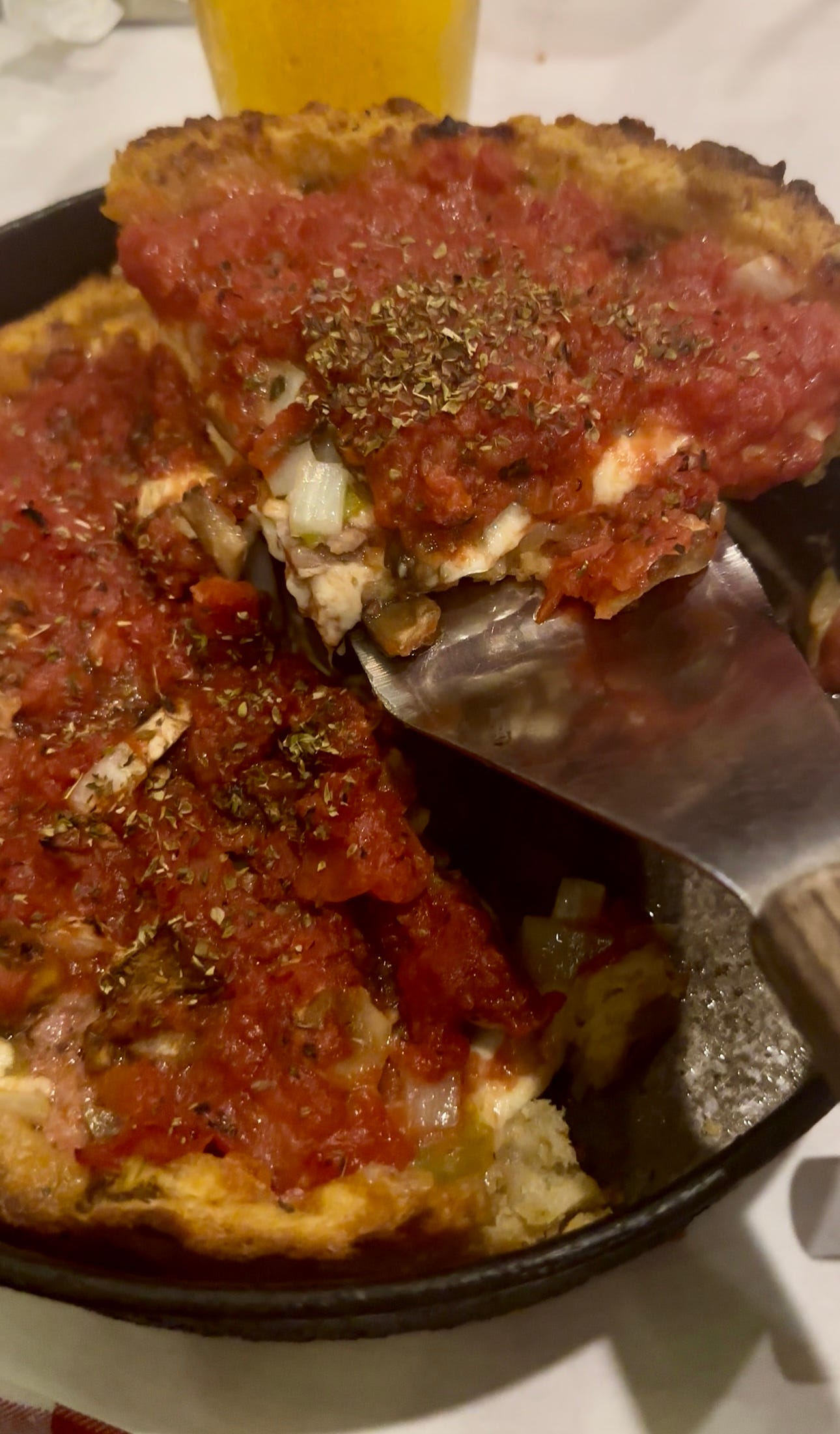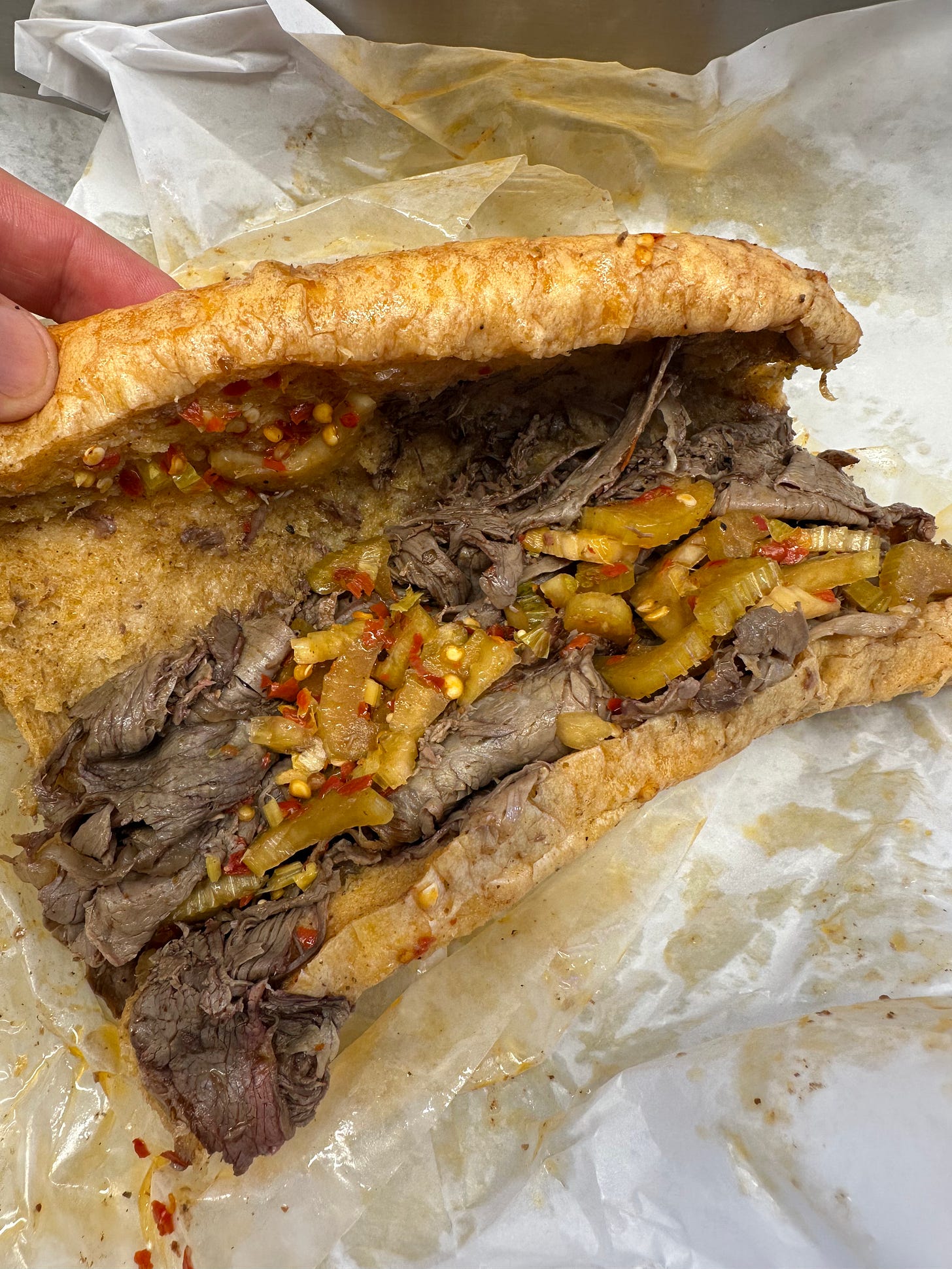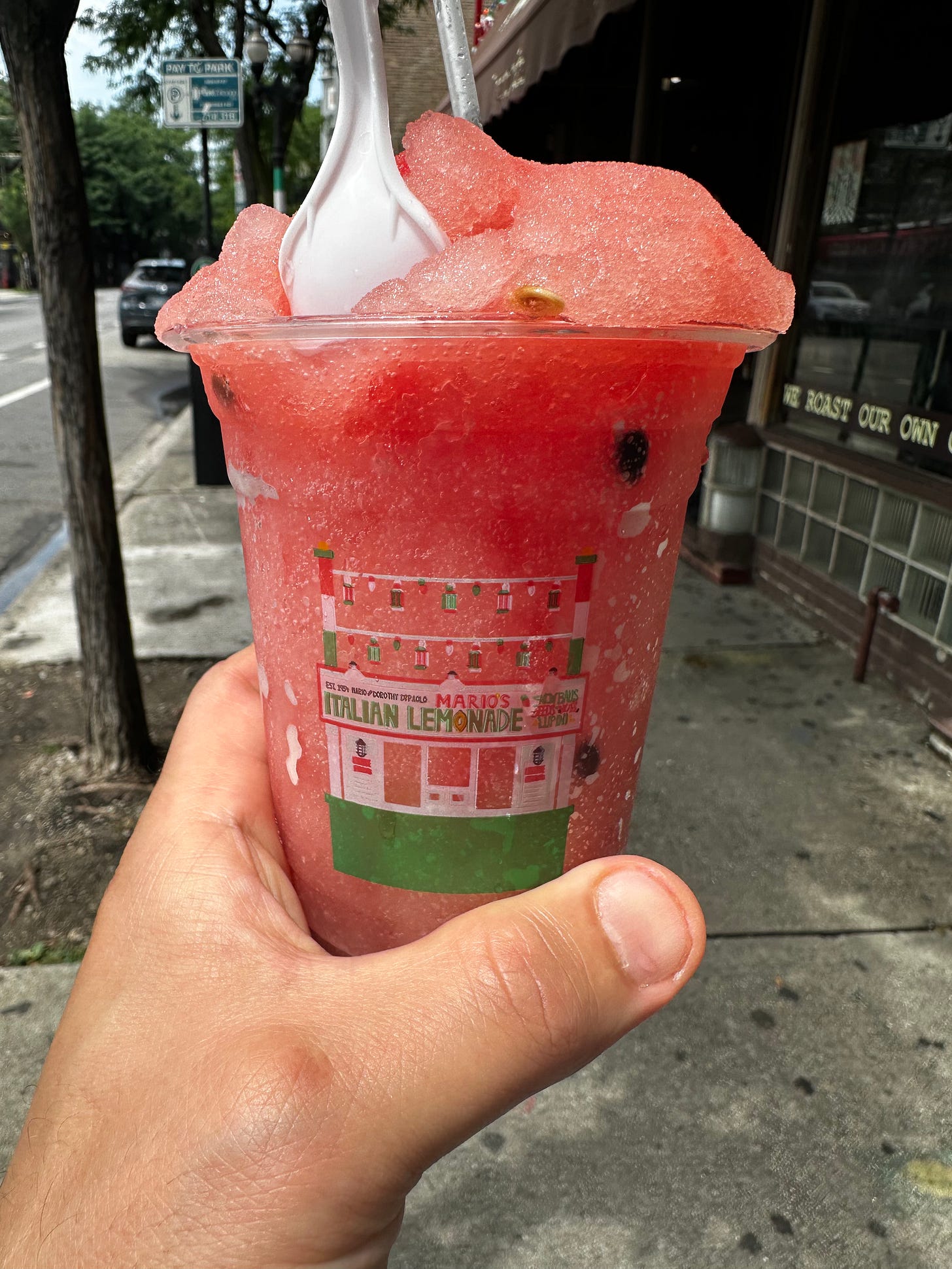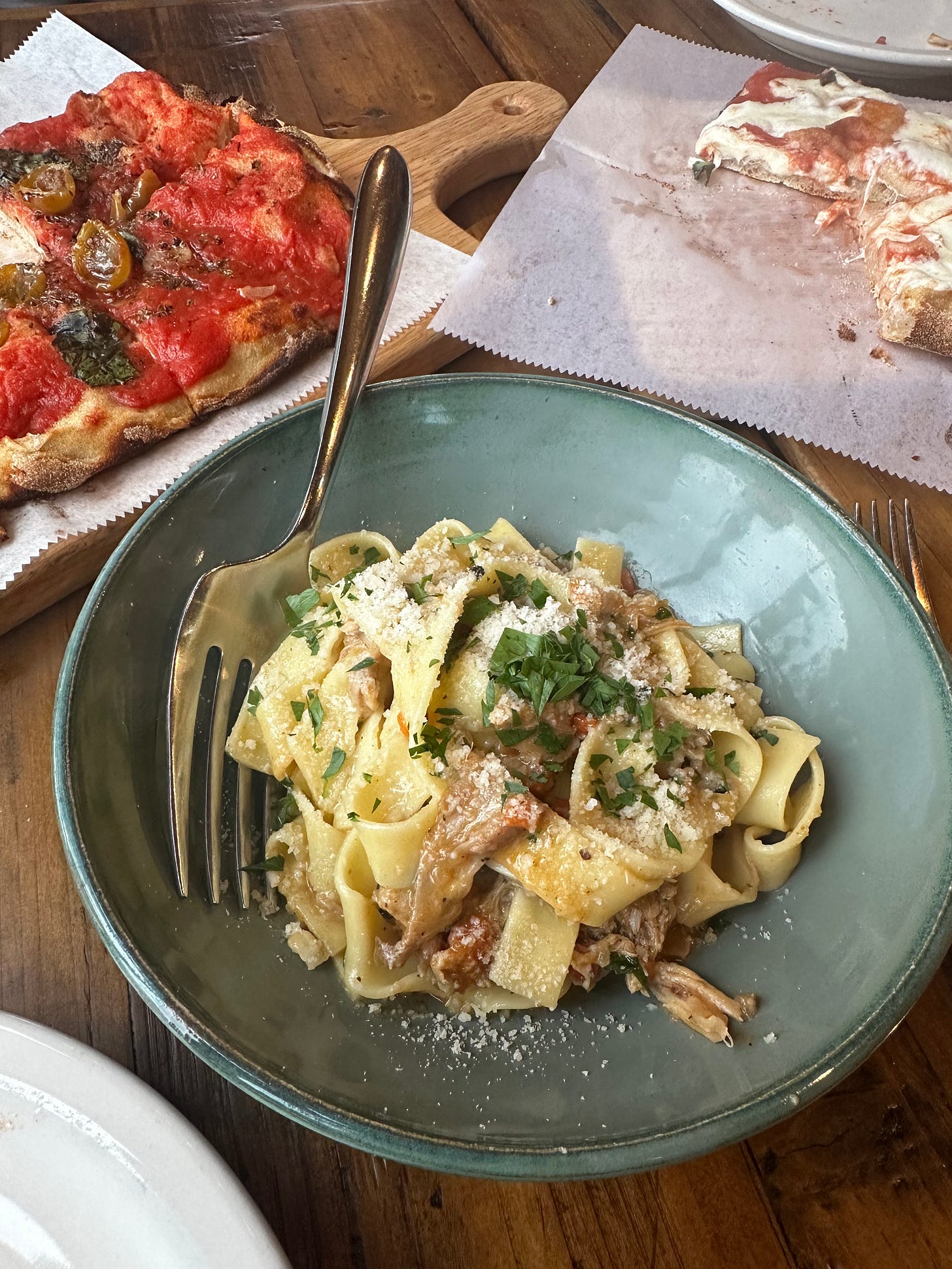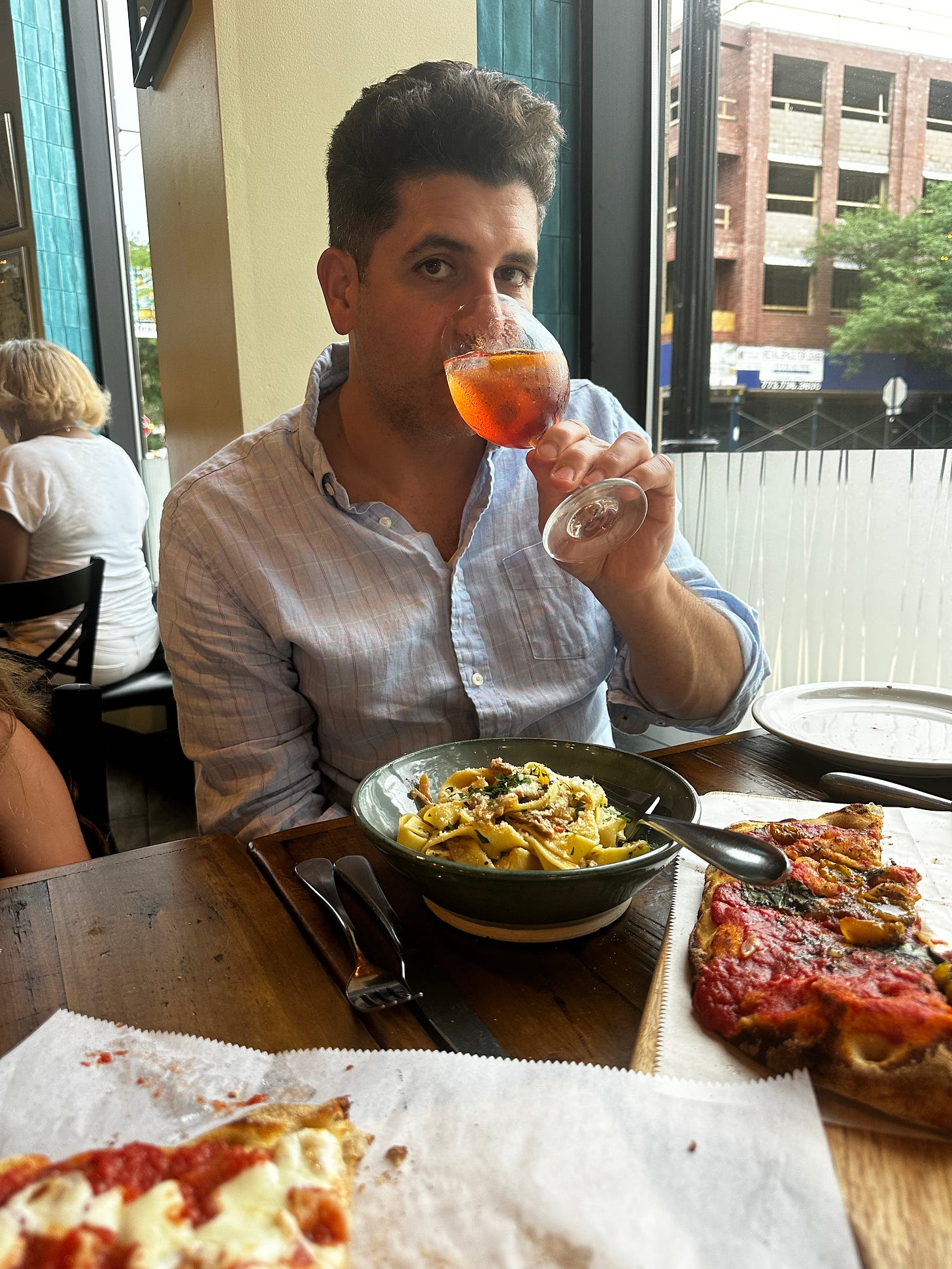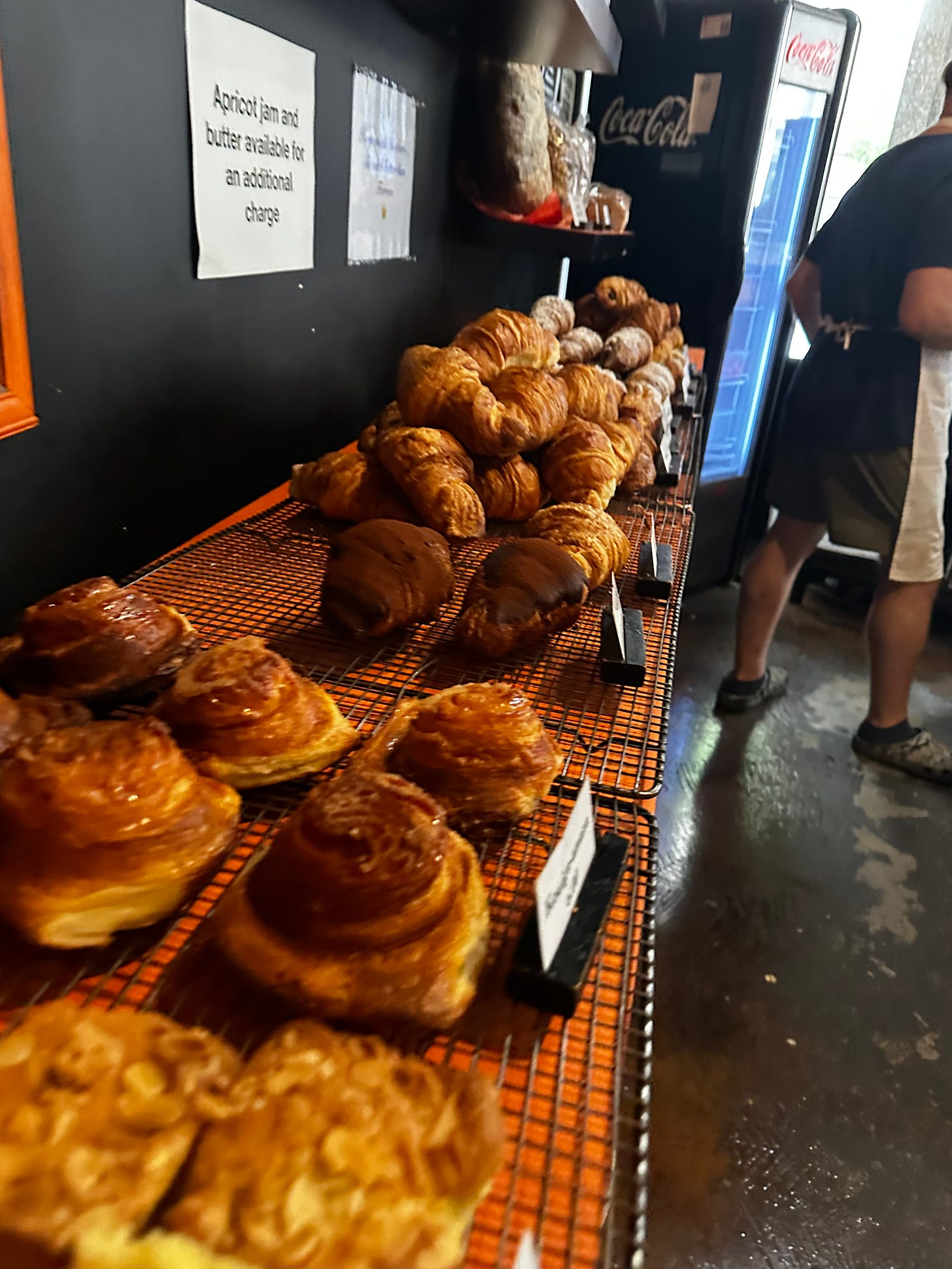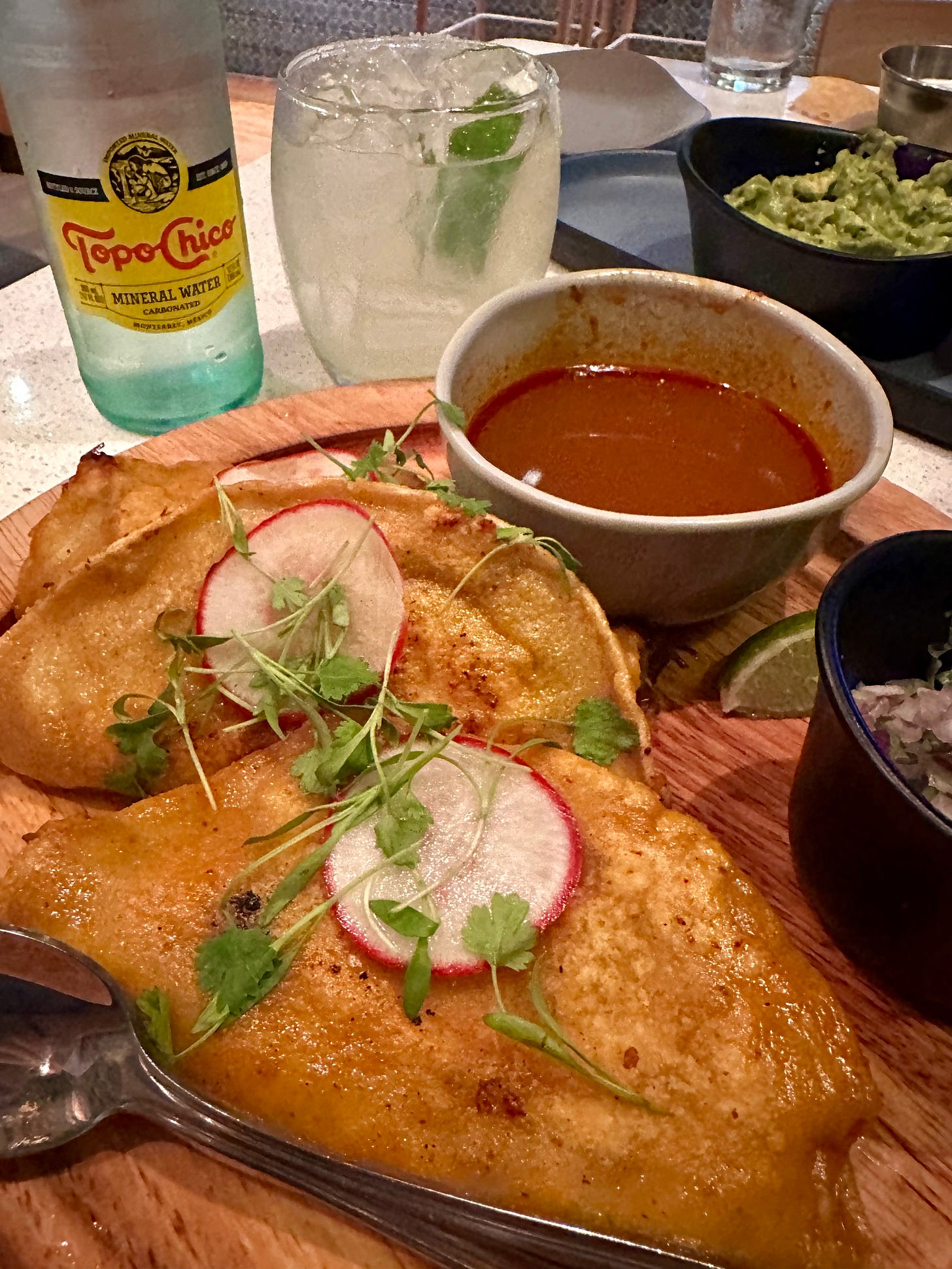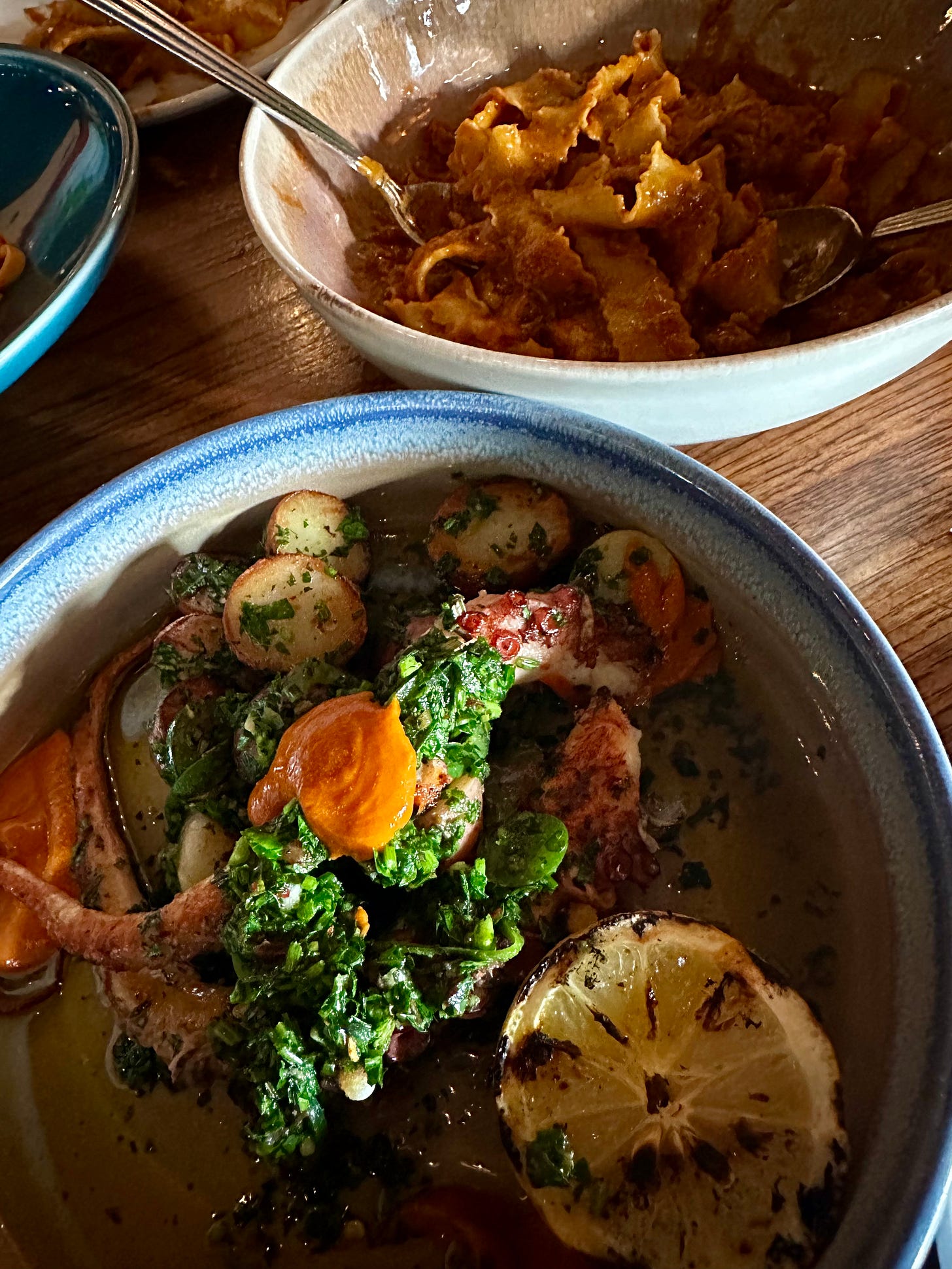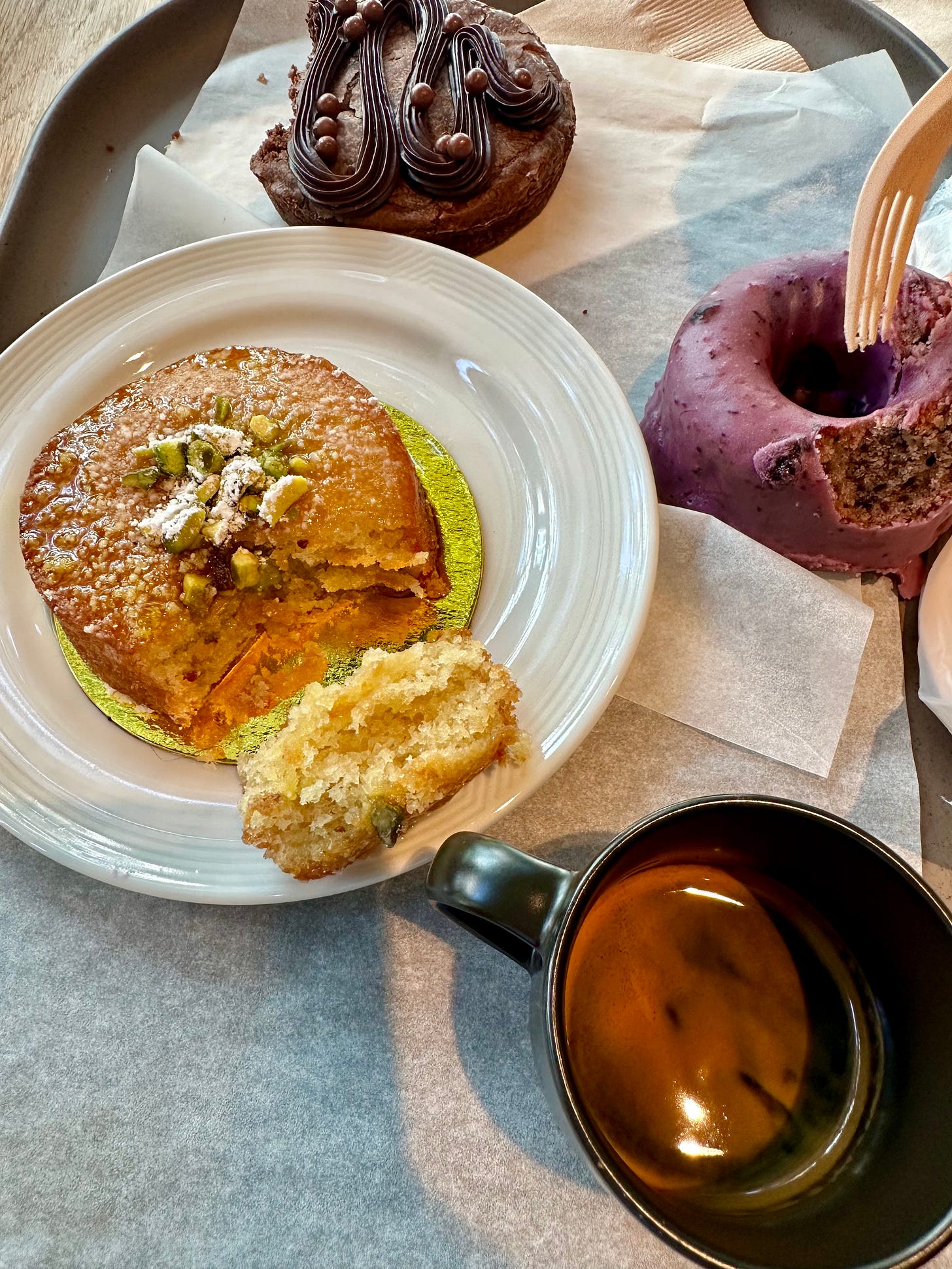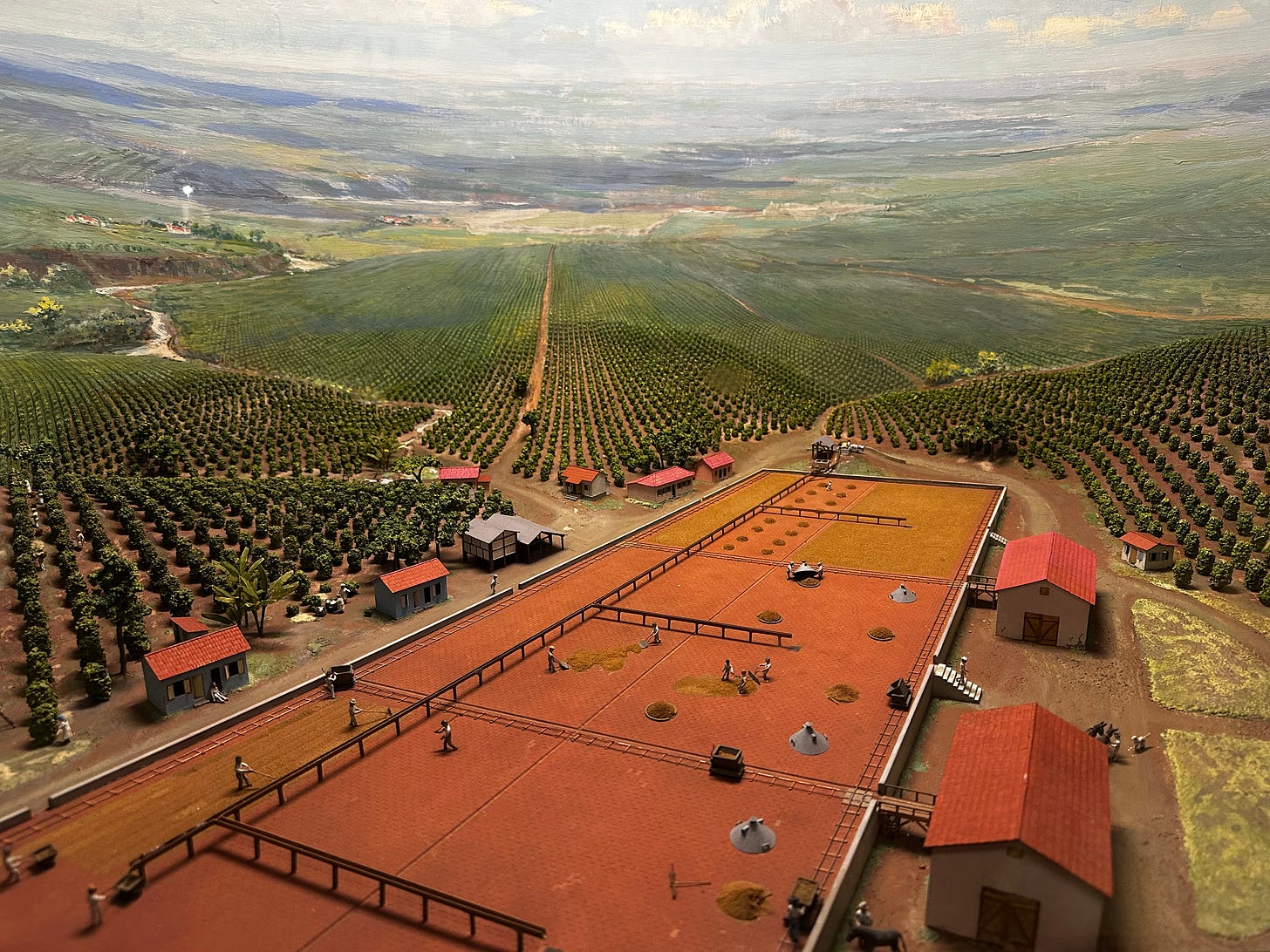It’s been almost eight years since I was last in Chicago, and this trip felt a little different. I used to come here often for wine events, but the industry has changed, and many of those professional tastings are no longer offered. This was more of a rogue visit—catching sips and bites wherever I could. Some old favorites are still around, but I wanted to try a mix of new spots too.
Pizano’s Pizza & Pasta
For my first stop, I went for an old-school deep-dish experience at Pizano’s Pizza & Pasta. We ordered the Special Double Deep Dish Rudy’s Pizza, loaded with sausage, mushrooms, green peppers, onions, and mozzarella, baked into that classic buttery crust. Exactly what I was looking for—cheesy, rich, and unapologetically heavy in the way Chicago deep-dish should be. A cold beer was a must.
Was it life-changing? No, of course not. But it was satisfying and hit the mark perfectly for the craving I had.
Pizano’s has several locations throughout the city, including Madison Street, State Street, Division Street, Clark Street, and Dearborn Station, plus a suburban spot in Glenview.
Al’s #1 Italian Beef
No trip to Chicago is complete without an Italian beef sandwich, and I wanted to do it right. We went to the original Al’s #1 Italian Beef in Little Italy, a spot that’s been serving this Chicago classic since 1938. What started as a Depression-era family recipe—thinly sliced beef slow-cooked in seasoned broth and served on fresh Italian bread—has become an institution.
I ordered the Italian beef, dipped, with hot peppers. “Dipped” means the whole sandwich is briefly dunked in the beef jus, soaking the bread in all that rich, brothy flavor. Every bite was beefy, juicy, and full of spice from the giardiniera. You can’t eat it cleanly, so you have to master the “Italian lean”—standing at the counter, leaning forward with elbows out to let the juice drip right onto the paper instead of down your shirt.
As a bonus, being in Little Italy meant Mario’s Italian Lemonade was right across the street. This historic stand has been cooling people off since 1954 and is still family-run. It’s not a typical lemonade but more like shaved ice with real fruit blended into it—light, refreshing, and perfect after a heavy beef sandwich in the summer heat. They had about fifteen flavors that day, from classic lemon to cantaloupe to lychee. I went with watermelon. All of their flavors are made from fresh fruit, which gives them this natural sweetness that feels like electrolytes in an iced cup. Exactly what I needed.
Munno
I was excited to try Munno after hearing about its Bib Gourmand status from Michelin. In France, I love Bib Gourmand restaurants—they’re not fine dining, but they serve excellent, thoughtfully made food at reasonable prices. That’s the whole idea of the Bib Gourmand designation: Michelin recognizes these spots for high-quality cooking without the formality (or cost) of a starred restaurant.
Munno specializes in Roman-inspired cuisine, and having been in Rome last summer, I was looking forward to revisiting some of those flavors. Not that I really needed to “reignite” my excitement for Roman cooking, but you get my drift.
I started with the suppli—fried tomato risotto balls with molten cheese inside. They were spot on, just like the ones I devoured in Rome. The pizzas were equally impressive, with that classic Roman-style balance of crisp crust and flavorful toppings. But my favorite dish of the night was the pappardelle al ragù di coniglio, basically a slow-reduced rabbit stew tossed with wide homemade pappardelle noodles. It was rich, delicate, and executed perfectly.
The cocktail list was also worth a look, full of all the classic Italian bitters and aperitivi. I went with a Negroni Sbagliato—still one of my favorites. You can catch my recipe for it in an earlier post if you want to make one at home.
Hendrickx Belgian Bread Crafter
I was craving a legit bakery after my trip to Belgium earlier this year, so I tracked down Hendrickx Belgian Bread Crafter in Streeterville—no regrets. Founded by Belgian chef Renaud Hendrickx and co-owner Dominique Schewebach, this family-run spot brings traditional Belgian techniques to the Gold Coast. They start baking at midnight so everything—from croissants (13 varieties) to country breads and classic pastries—is fresh and made from scratch.
It wasn’t just Belgian standards on offer: they had French classics too, like kouign-amann from Normandy. I tried an apple strudel with a café au lait—flaky, comforting, and perfectly paired. Not too sweet. The warmth from the family behind the counter and the open kitchen gave the place a cozy, welcoming vibe. They even showed us to an indoor seating nook behind the prep area.
If I lived nearby, I’d be a regular, slowly working my way through the lineup of viennoiserie and breads.
Mercadito
We stopped in here for lunch on a Saturday and wow—this place is wild. Located in the heart of River North, Mercadito is a vibrant Mexican restaurant known for its elevated take on traditional flavors, bold cocktails, and high-energy atmosphere. On our visit, there were birthday parties in full swing, music bumping, a real party vibe.
As a mezcal fan, I was impressed by their extensive mezcal list and cocktail program. I’m that guy who usually takes a margarita recipe and swaps tequila for mezcal, so I felt right at home here.
For food, I ordered tacos al pastor and birria tacos. The pastor, made with ancho-rubbed pork, chile de árbol salsa, and tiny diced pineapple, was my favorite. That little hit of sweetness in every bite is why al pastor will always be my preferred taco. The birria tacos were braised short rib quesabirria with crispy corn tortillas, Chihuahua cheese, and a side of consommé for dipping. I’ve been enjoying birria tacos a lot lately, and this one delivered on that rich, meaty flavor, but the pastor still won for me.
This place is definitely worth a stop if you want mezcal and tacos in a lively setting.
The Purple Pig
I’ve been here multiple times before, and it’s always been one of my favorite Chicago stops. The Purple Pig has been a city mainstay since opening on Michigan Avenue in 2009 under chef Jimmy Bannos Jr. It became an instant hit—part communal Mediterranean meat-and-cheese hangout, part wine bar, and entirely buzzy food destination. Even after 15 years and a move to a larger 120-seat space in 2019, this place is still jam-packed every night—a reservation is absolutely a must.
On this visit, we ordered the spicy octopus—marbled potatoes topped with jalapeños, sambuca, chimichurri, and almonds—and the tagliatelle with lamb ragu, onions, crispy guanciale, and manchego. Both dishes hit right: the octopus was tender with a nice heat and nutty snap, while the tagliatelle was rich, earthy, and perfectly balanced. The wine list remains huge and deeply inspirational—still a treasure trove for any sommelier or wine lover.
Starbucks Reserve Roastery
I’m pretty picky about my coffee—at home I roast my own beans, grind them fresh, and pull espresso with a traditional manual machine. But let’s be real: when I’m traveling, sometimes Starbucks is the only espresso game in town, and in a pinch it works. I’d never been to a Reserve location before, so I made a point to visit the Chicago Roastery—and I was genuinely impressed.
This spot is unlike any regular Starbucks. Housed in a former Crate & Barrel flagship on Michigan Avenue, it spans five stories and about 35,000 square feet, making it the largest Starbucks in the world. Its design puts coffee roasting centerstage: giant copper pipes lift beans between floors, and you can actually watch the process as you wander.
Each floor offers something different—the Princi bakery for pastries, pastas, and pizzas, a specialty brew bar for coffee flights, a cocktail bar with coffee-inspired drinks, and even a rooftop terrace. We went on a Thursday afternoon and had no trouble getting in, but walking by on Saturday there was a line of at least 50 people outside.
I was pleased to see coffee roasting in action and food options you can’t get at a standard Starbucks. It felt more like visiting a high-end café or micro-roastery than just grabbing coffee before your day.
I wrapped up the day with a visit to the Field Museum, where I spotted this display showing how coffee is dried on Brazilian plantations before being prepared for market. Brazilian coffee has always been one of my favorites to roast for espresso—balanced, rich, and with that nutty sweetness I look for in a great shot.
Stay tuned—my next newsletter drops at the beginning of the month.


